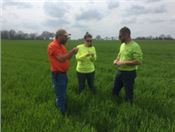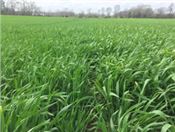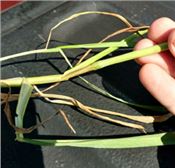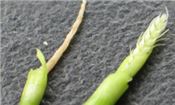|
Wheat Freeze Damage Update, Management And Haylage

DR. TYSON RAPER
KNOXVILLE, TENN.
Reports of no freeze damage received early last week (3/20) were replaced with reports of slight to severe freeze damage by the end of the week (3/24). This article describes how to determine damage, what types of damage have been noted, and management of freeze damage wheat.
Determining Damage
As a whole, the growth stage at the time of the freeze and location have been the best two predictors of the level of damage. Growing points (heads) which had moved 6-10 inches above the soil surface appear to be the most damaged. The relationship between location and level of damage appears to be loose; generally, fields south of I-40 appear to have less damage than those north of I-40 but there are several exceptions to this rule. Although one might expect planting date and maturity of the selected variety to dominate maturity at the time of the freeze and subsequently level of damage, dry conditions at planting delayed emergence and subsequently delayed maturity in some fields. To further complicate freeze injury prediction, the period of time below freezing and low temperatures recorded varied across West Tennessee. With that said, it is almost impossible to gauge level of damage without scouting each of your fields.
In order to gauge injury level, break fields out by management zones and collect tillers in a manner similar to soil sampling; all tillers should not be collected from one area. More injury will likely be noted on exposed field edges, low areas and immediately adjacent wheel tracks as these areas will typically cool faster than the rest of the field. Identify primary and secondary tillers and inspect for injury described below. While assessing damage, consider that the plant will likely compensate for aborted tillers.
Types of Damage

Leaf Damage
Leaf tip burn and or twisting began to appear in many fields mid-week. This is typically cosmetic, given the flag leaf had not emerged. Yield penalties from leaf burn will likely only be noted if the flag leaf has been injured. Leaf injury can vary by varieties. The left half of this image was planted to a different variety than the right half. The faint yellow tinge present on the right side of the image is due to leaf tip burn.

Stem Damage
Elongating stems are particularly susceptible to freeze damage. Many areas in West Tennessee were cold enough to freeze stems. Visual symptoms vary. Injured stems may be soft and fragile or may be split. When sliced, stems which have been only slightly injured may be hollow and appear water soaked. If severe, stems may appear rotten. If the level of injury is not substantial enough to terminate the tiller, injured stems will be more likely to lodge. The first stem pictured below was only slightly injured by the freeze but it can no longer support the weight of the tiller and has lodged. The second stem pictured was severely injured and is beginning to rot.

Head Damage
Moderate to severe levels of growing point (head) damage were reported late last week. Injured heads appear shriveled and do not look like miniature versions of mature heads. By now, many of the injured heads will appear yellow, tan or white and look more like paint brush tips than wheat heads. Terminated heads will cause the highest yield penalties. Compensation from secondary tillers can prevent severe yield penalties but harvest date may be delayed. Below is a picture of healthy heads (right) versus injured heads (left).
Management
Slight to moderate damage (20-30 percent head injury, 10-20 percent stem damage) characterizes many of the fields I have walked. In these fields, I would encourage you to adjust yield goals and manage the crop accordingly. Keep in mind that plants which are nitrogen stressed will not be able to compensate for aborted tillers. Also, tiller abortion which leads to additional tillering may result in a very dense canopy and can favor the development of diseases. Closely scout fields and use fungicides if necessary.
I’ve only walked a few fields which sustained enough damage to consider terminating (in excess of 80 percent head and stem damage). The list factors which should be considered before terminating are substantial and include insurance, inputs applied, plant-back restrictions from herbicides used and cash flow, to list a few.
Haylage
In some of the worst damaged areas, questions on grazing and/or haylage have been raised. The major concern with converting wheat managed for grain to haylage will be nitrates; wheat managed for grazing or haylage typically receives less nitrogen fertilizer than wheat managed for grain. For those considering haylage, clip a sample of the wheat, notify your county agent and send the sample to the Soil, Plant and Pest Center in Nashville. Samples should be collected 7-10 days prior to the planned cutting date. If the sample has 3,000 ppm nitrates or less, it will generally be safe to feed to cattle. If the analysis reports greater than 3,000 ppm, delay the cutting (if possible) and resample 7-10 days prior to the new planned cutting date. Fortunately, there is a wide window in which wheat can be cut for haylage and nitrates within the plant will decline over time. Additionally, nitrate concentration will continue to decline after the haylage has been wrapped. Contact the UT Beef and Forage Center for additional information on haylage and nitrates. ∆
DR. TYSON RAPER: Cotton & Small Grains Specialist, University of Tennessee
|
|